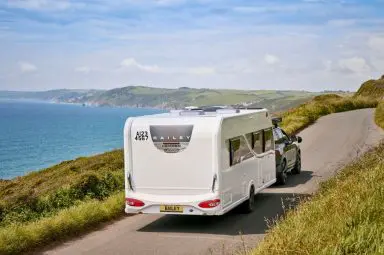Dogs in Caravans: The Ultimate Guide for UK Tourers
In fact, caravans are the top choice for pet-loving travellers, with 43% preferring caravans over campervans (19%) and motorhomes (17%).
So, whether you’re new to the world of caravanning and wondering if it’s a good fit for your four-legged friend, or a seasoned tourer with a new pet to bring along on holiday, the stats are in your favour.
But what’s the best way to do it? This guide will show you how to make your caravan trip safe and enjoyable for both you and your dog. Let’s get into it.
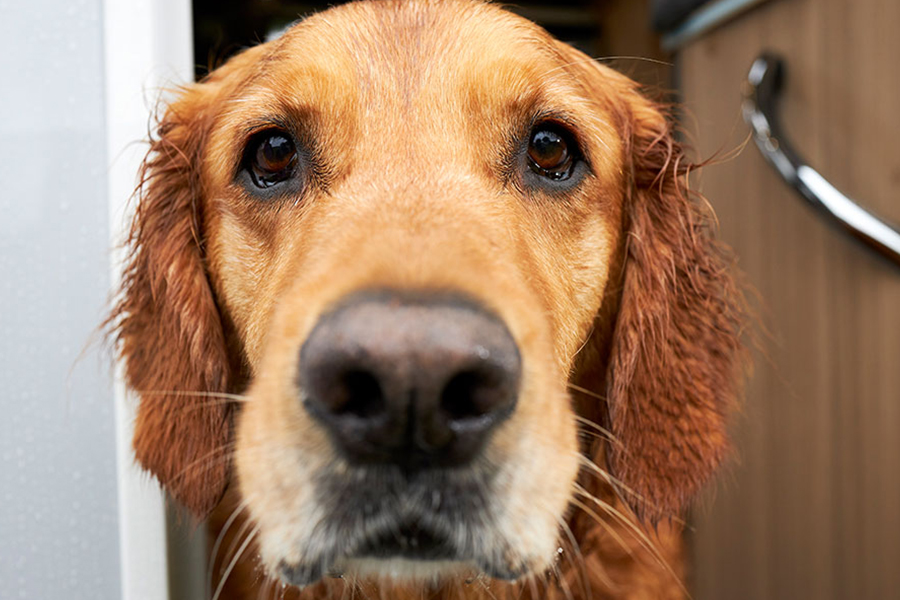
The big question: Can dogs travel in caravans?
Dogs can certainly live in caravans when they are parked and secured, but they shouldn’t travel in them while they are being towed.
While it’s not technically illegal in the UK to have a dog in a caravan while it’s being towed, it’s strongly advised against and for many good reasons:
- There’s no safe way to secure your dog in a towed caravan: Unlike cars, caravans don’t have harness points or seat belts, so if you brake suddenly or swerve, your dog could be seriously hurt.
- Your dog could become distressed: Being left alone in a moving vehicle with unfamiliar sounds, bumps and movement.
- You won’t be able to check on them: For water, comfort, temperature or toilet needs while they’re out of sight in the caravan
The best and safest place for your dog is always in the car with you when towing. We’ll cover how to keep them comfy and secure while traveling a little further down in this guide.
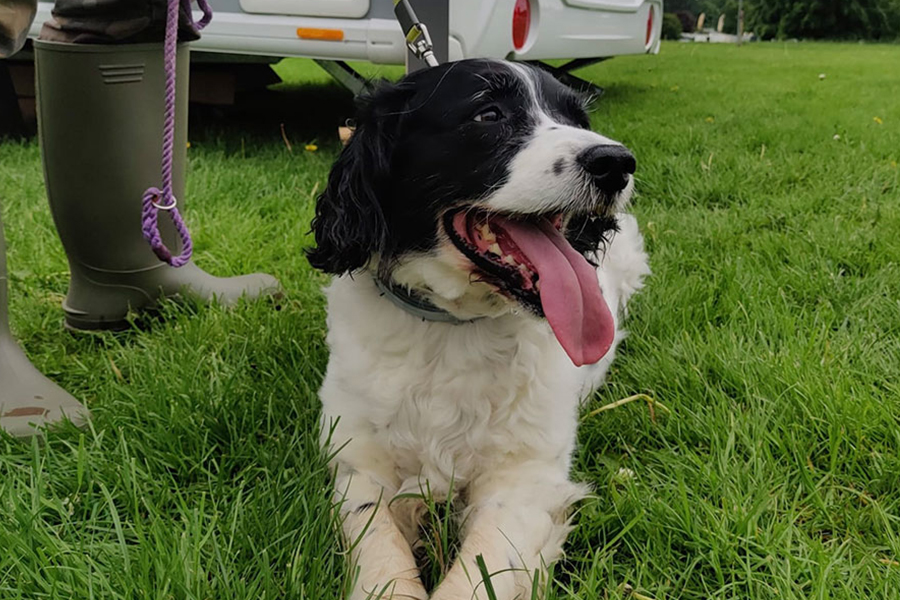
How to plan for a caravan holiday with your dog?
Here’s how to make sure everything’s in place so you can relax and enjoy the trip.
How to sort the dog travelling essentials?
If you’re staying within the UK:
- Microchip: Your dog should already be chipped by law, but it’s especially important when you’re away from home. New places = new smells = lots of curiosity, which can sometimes lead to wandering off.
- ID Tags: Make sure your dog’s collar has clear ID. Include their name, your name, a mobile number and even your campsite name if you like. It’ll help anyone who finds them get them back to you quickly.
- Pet Insurance: If you don’t have it already, get insurance sorted before you go, and keep the policy info handy: either printed or saved to your phone, tablet or laptop.
- Vaccination Records: These should be up to date and easily accessible, especially in case of emergencies.
- A Recent Photo: Hopefully, you’ll never need it, but having a clear, recent picture of your dog can make all the difference if they go missing.
If you’re heading into the EU
You’ll need all of the above, plus a few extra steps:
- ISO-Standard Microchip: Your dog must be chipped to ISO 11784/11785 standards either before or at the same time as their rabies jab.
- Rabies Vaccination: Legally required for EU travel.
- Animal Health Certificate (AHC): Since Brexit, UK pet passports are no longer valid for EU trips. You’ll need to get an AHC from an official vet within 10 days of travel. It’s valid for one trip and up to four months of onward travel in the EU.
- Tapeworm Treatment: Required 1–5 days before entering countries like Ireland, Norway, Finland and Northern Ireland (also needed before re-entering the UK). This must be done and signed off by a vet.
It’s worth speaking to your vet in good time before your trip, especially if it’s your first time taking your dog abroad. You can find full details of all the steps you need to take before travelling with your dog on the government information page here.
How to find a dog-friendly campsite?
Not all campsites are pet-friendly, so it’s always worth double-checking before you book. Look out for dog-friendly caravan sites that offer:
- A dog walk area (ideally one that’s fenced, so your dog can roam safely off-lead)
- Poo bins placed around the site
- Easy access to longer walks or nature trails
- A small on-site shop with dog food, treats or other essentials
Even when dogs are welcome, each campsite has its own specific rules, so check leash policies (e.g. on-lead at all times, or tethered outside the van), and see what the local area has in terms of dog-friendly pubs, cafés and beaches.
What are the top club sites for dog owners?
- The Caravan & Motorhome Club – Filter by dog-friendly caravan sites when searching
- The Camping & Caravanning Club – Same goes here, and you can add filters for family-friendly features too
These tools are great if you’re looking for a site that needs to cater to your dogs and the entire family. You’ll be able to search for everything from pet zones to play areas and clubhouses for the kids.
Top tip: Search for honest recommendations
Have a look at online forums or Reddit threads to see which campsites, walks and attractions are favourites with fellow dog owners.
It’s a great way to plan your trip around places that actually deliver on the ‘dog-friendly’ promise.
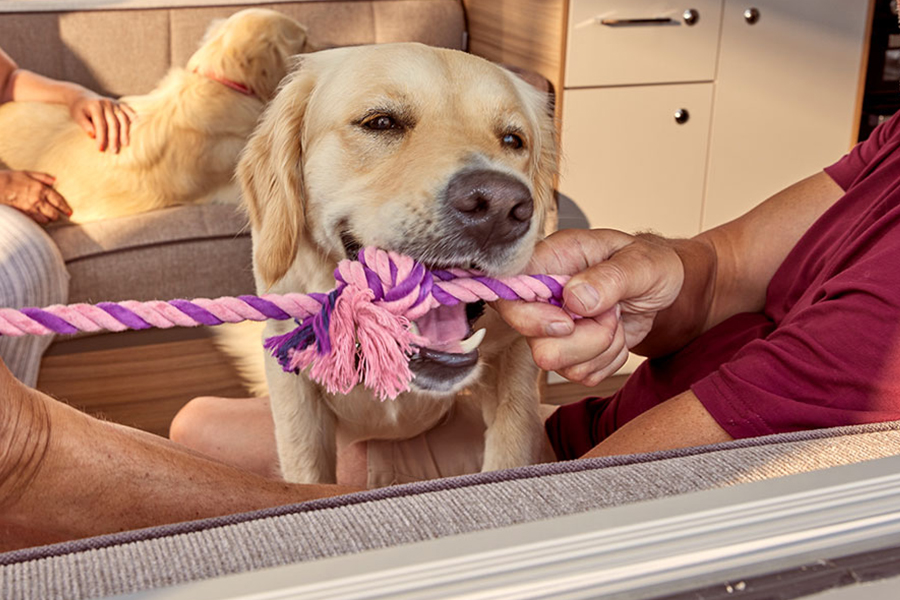
How do you keep your dog secure while travelling?
When you’re heading off on a caravan trip, your dog’s safety in the car is just as important as your own. According to section 57 of the Highway Code, pets must be “suitably restrained” when traveling in a vehicle.
So, what does that mean in practice?
First things first: your dog should always travel in the car with you, not in the caravan while it’s being towed. We covered why earlier, but in short, it’s about keeping them safe and close enough that you can keep an eye on them.
Here are your main options for keeping your dog secure in your car:
- Dog carriers / crates: Great for dogs who like their own space. They’re enclosed, secure and can be fixed in place in the boot or footwell. A solid choice for calm travelers who settle quickly.

- Dog harnesses: Ideal for dogs who aren’t keen on crates. These attach to your car’s seatbelt system and keep your dog safely in place while still giving them a bit of freedom to move.
- Dog car seats: Perfect for smaller dogs who like to see the world go by. These booster seats secure into the car using the seatbelt and give your pup a view out the window safely.
- Dog guards / boot grates: If you’ve got space in the boot and your dog’s used to traveling there, a fitted grate (between boot and back seat) gives them room to stretch out without climbing forward.

Why does your dog need to be restrained?
Aside from the safety side of things, dogs who are loose in the car can become a real distraction. If they get nervous, excited or decide your lap looks like a nice place to be, it can pull your focus from the road, which is dangerous for everyone in the car.
How to keep your dog safe and comfortable while travelling?
Security is only half the story. Here’s how to make sure your dog is comfy while you’re on the move:
- Water: Keep fresh water close by, and offer regular sips, especially on hot days.
- Walks: Plan breaks every 1–2 hours on long journeys so your dog can stretch their legs, sniff and have a toilet break.
- Temperature: Use your air con to keep the car cool. If you’re feeling warm, your dog’s probably roasting. Watch out for panting because it’s a key sign they’re too hot.
- Calm routes: For nervous dogs, stick to quieter roads where you can. Avoid loud motorways or city traffic if possible.
- Tech help: A pet camera or rear-seat dog monitor can be a great tool, especially if your dog’s behind you and you want peace of mind.
Top tip: If this is your dog’s first proper trip, start small
Choose a campsite within 30 minutes of home to help them adjust. You can build up to longer drives as they gain confidence.
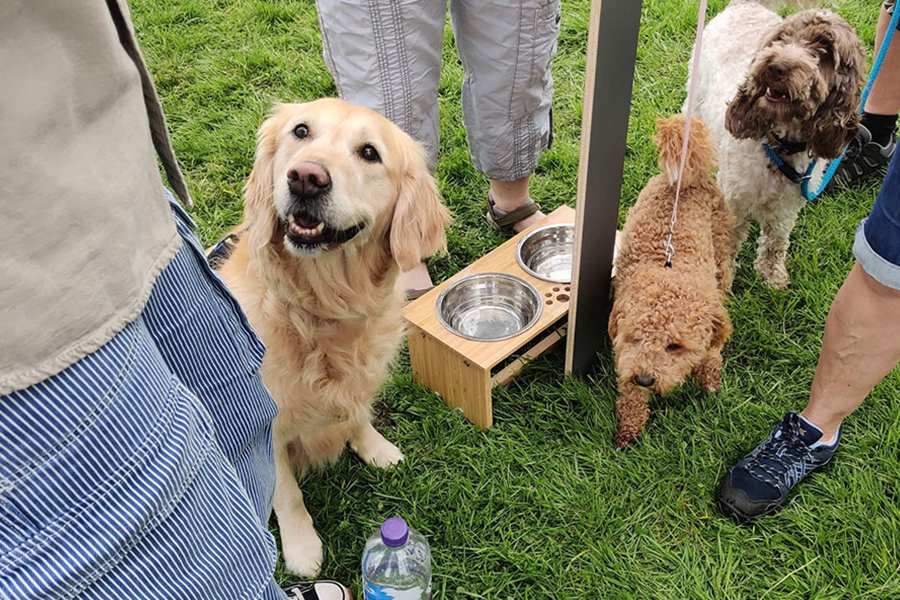
How to set up your caravan for your dog?
There’s a lot you can do to help your dog settle in and feel right at home in your caravan; think of it as creating a little “home within a home” just for them.
Inside the Caravan

- Give them a quiet spot. Your dog will appreciate having their own space to relax in. That might be a crate in the corner, a pet bed under the table, or even their favourite blanket laid out on the sofa (with a throw over it, if you’re keeping things clean).
- Keep food and water accessible. Set their bowls somewhere they can always reach. Ideally somewhere wipe-clean like the washroom floor. Just remember to keep the door open!
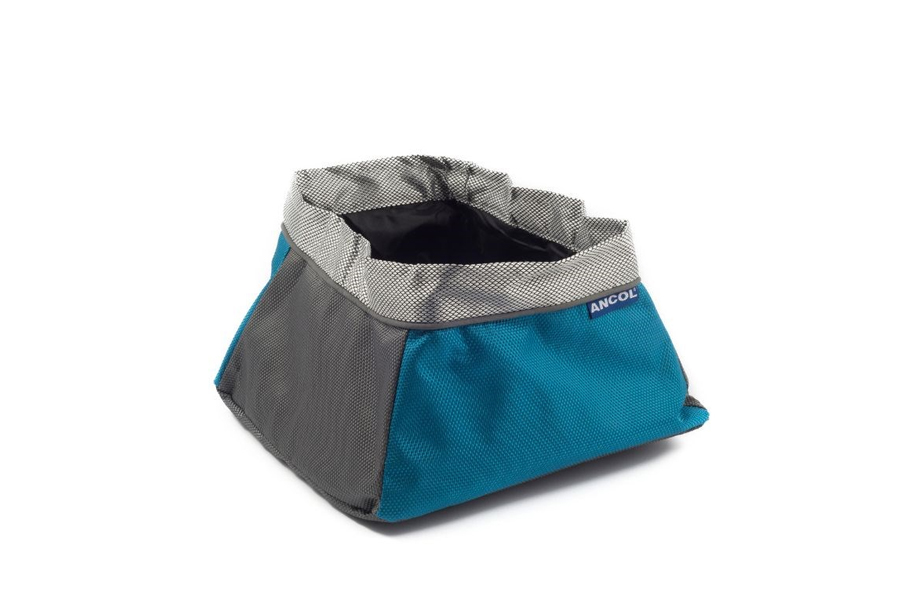
- Do a quick hazard sweep. After every setup, have a look around at dog height. Tuck away loose wires, snacks, small objects or anything chewable, especially if your dog’s curious or still young.
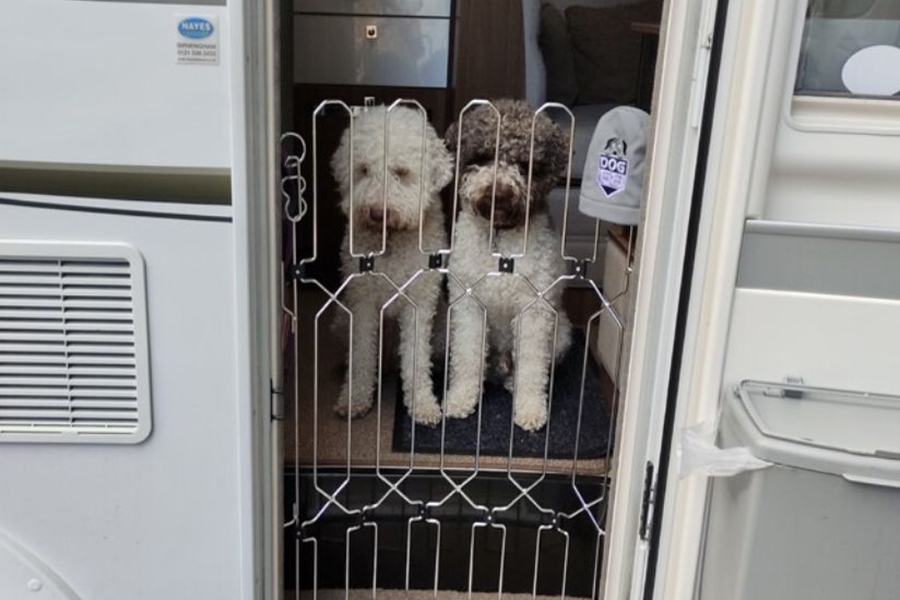
- Use a dog-proof door screen. Lots of caravans come with mesh or flyscreens that let you keep the main door open without your dog doing a runner. If yours doesn’t, it’s worth getting one; they’re a great way to get fresh air while keeping things safe.
- Protect your upholstery. If your dog’s a sofa-lover or a bit muddy after walks, you might want to throw covers over your cushions or beds. It’s a quick way to stop messes or scratches from becoming a problem. Another great option is a portable pet-washing device that allows you to wash your dog off before they even enter your van
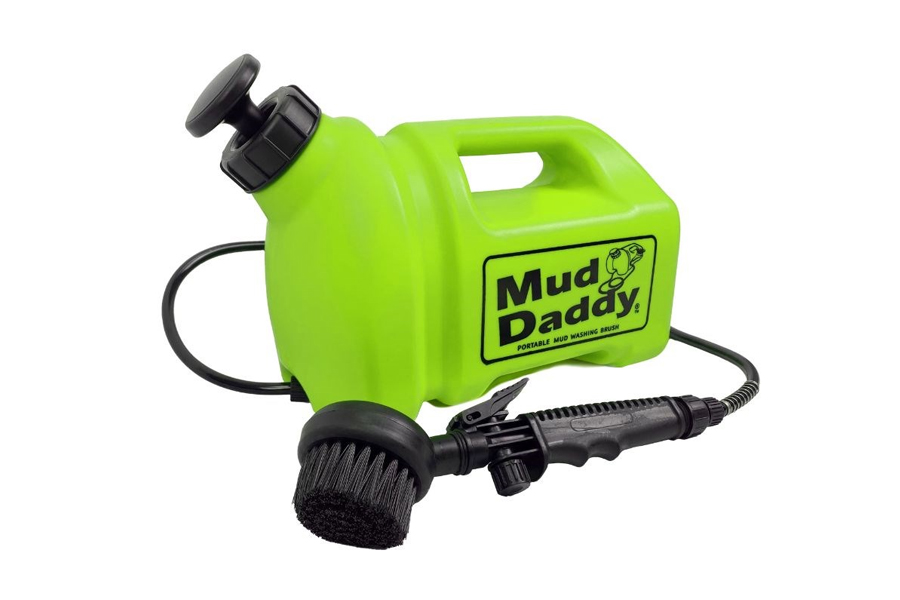
- Manage the temperature. Caravans can get hot fast, so make use of skylights, windows and fans to keep things cool. If you’ve got flyscreens, open the windows fully and pull them down. That way you get the right airflow without risking an escape. If you don’t have flyscreens? Try putting the windows on the latch instead.
Outside the Caravan
- Set up an awning. Awnings are brilliant for dogs. They give them a safe outdoor space to stretch out, relax, or just watch the world go by, and they effectively double your dog’s freely available exploration space.
- Use a dog tether. If you’re sitting outside and want your dog to join you, a ground peg with a long lead or retractable line is ideal. You can relax without worrying they’ll wander off.
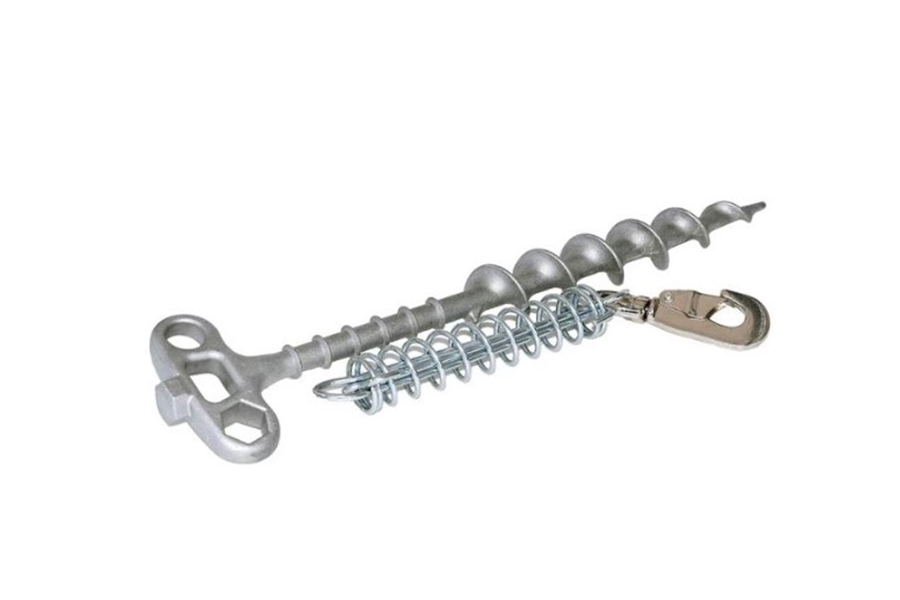
- Give them an outdoor bed. Whether it’s a raised dog bed, a picnic blanket or something waterproof, make sure they’ve got somewhere comfy to chill out, ideally in the shade.
Where Do Dogs Sleep in a Caravan?
In a caravan, your dog could sleep in your bed, on a spare bed, on the floor, on a sofa, or in a dog crate on the floor. Some owners allow their dog to sleep in the awning. Your dog can sleep wherever is safe for them and wherever they feel most comfortable.
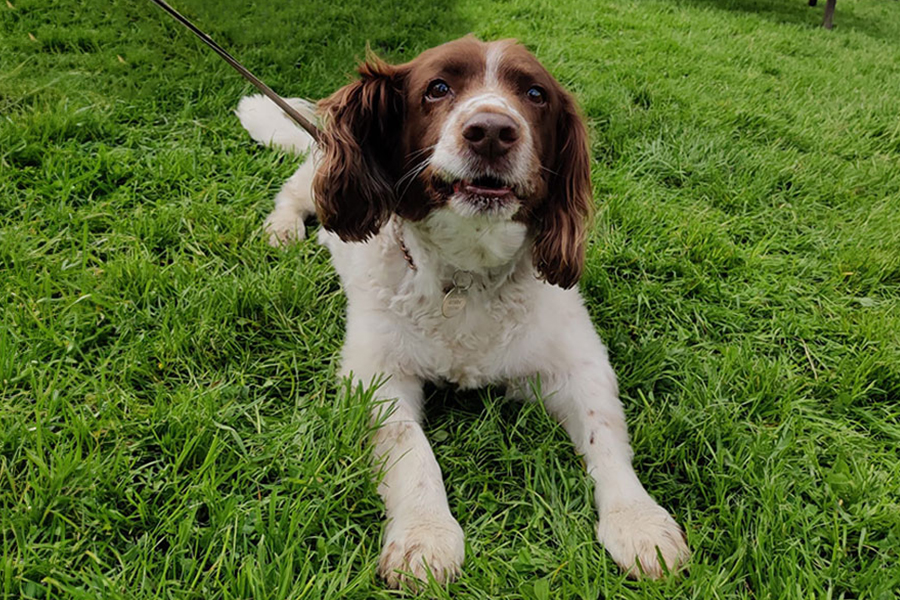
What to pack for taking your dog in a caravan?
Essentials
- Dog poo bags
- Doggy shampoo
- Extra food and water
- Familiar food and treats
- Dog towel
- Spare leash and collar
- Pet peg
- Documentation showing vaccination history
- Dog passport
Health and Safety
- Doggie medicine
- Dog brush
- Collar with your contact details
Comfort and Entertainment
- Dog toys
- Dog towel
- Dog brush
Travel
- Dog car harness / Dog seat belts
- Dog crate / Travel crate
What campsite etiquette for dogs should you be aware of?
- Keep your dog on a lead: Unless you’re in a clearly marked off-lead area, it’s best to keep your dog close by. Bear in mind that even the friendliest dogs can surprise you when they’re in a new environment with lots of new smells, people and pets.
- Never leave your dog unattended: Even if you’re just popping out for a quick moment, leaving your dog alone in the caravan or awning isn’t a good idea, especially in warm weather. You can be sure of your dog’s wellbeing by keeping them with you.
- Always clean up after them: Bring plenty of poo bags (biodegradable if possible) and make use of the bins provided. It’s a small thing that makes a big difference for everyone else on site.
- Be mindful of barking: Dogs bark, it’s what they do. But if your dog is barking constantly or getting worked up outside, especially during quiet hours, it can quickly become an issue. Keep an ear out and bring them inside if they’re unsettled.
- Ask before saying hello: Not all dogs, or other owners, are ready for a meet and greet. It’s always polite to check before letting your dog approach someone else’s pitch.
- Check each site’s rules: Every campsite is a bit different. Some won’t allow dogs in shared spaces like playgrounds or clubhouses, and others may have specific leash or noise policies. A quick check when you arrive keeps everything simple.
- Pick your pitch wisely: If your dog is particularly energetic or reactive to new sightsm sounds or smells, aim for an end pitch or one close to walking paths. The trick is to find one that’s a bit more away from it all (for less stimuli) while having a bit of extra space.

How to explore a new local area with your dog?
One of the best things about taking your dog on a caravan holiday is how many places you can explore together.
That said, it’s always worth checking ahead for any restrictions, especially on beaches. Many popular UK beaches have seasonal dog bans in place from May to September, so a quick look online before you set off can save a lot of hassle on the day.
Pack with the weather in mind. British holidays can bring a bit of everything, so it’s a good idea to have a drying coat or towel handy, along with some paw wipes or shampoo if your dog likes diving into muddy puddles. And don’t forget the lead, water bottle and a few treats for longer walks.
Try to include your dog in the day’s plans as much as possible. You may go for lunch in a dog-friendly pub garden, spend some quiet time at the campsite or have a kickabout or a paddle by the river. Your dog will like the time spent together.
If you’re staying put for the day, you could try leaving the car behind entirely. Car-free days are a great way to explore more slowly and give your dog a break from travel. A gentle walk into town or a ramble along a nearby trail can be just the thing. Or, for types who love a bit of history and green space, many National Trust properties are dog-friendly; just be sure to check each site’s policy before you go.
How to get your dog familiar with caravanning?
Start with a small trip
Begin with short, local trips. Let your dog explore the caravan while it’s parked without any pressure, just time to sniff around and settle. Bring familiar things like their bed, toys or blanket so it already feels a bit like home.
Once they’re comfy with that, try a short drive. Build up gradually to longer journeys so the movement, sounds and routines don’t come as a surprise.
Get your dog used to the crate being a safe space
If you’re using a crate for travel or sleeping, help your dog feel at ease with it at home first. Add their favourite blanket or toy, and reward them for going in on their own. Practice short car trips with the crate before your holiday.
Keep their routines consistent
Dogs love routine, and that doesn’t change just because you’re on the road. Try to keep walk times, mealtimes and bedtime roughly the same as at home. If they’re sleeping in a crate or travel bed, get them used to that setup before you leave.
Prepare your entire family
If you’ve got younger kids, it’s worth helping them get used to holidaying with the dog too. Encourage calm, respectful play inside the van and give kids small jobs like topping up the water bowl or helping with the lead. It teaches responsibility and keeps things running smoothly.
Gradually build their confidence
Expose your dog to different sights, sounds and settings: think campsites, service stations, parks. Play recordings of traffic or campsite noise at home if they’re nervous. And practise what you’d do in an emergency, like if they slipped their lead. A little preparation goes a long way.
What if your dog has an emergency when caravanning?
- Pack a dog first-aid kit: Just in case. Include tick tweezers, bandages and anything your dog regularly needs.
- Save local vet numbers: Do this before you travel so you’re not scrambling in a panic.
- Download a pet care app: Pet First Aid UK and Dog Tracker Plus are both handy to have.
- Look at your caravan insurance: Some policies cover pets, but not all. Worth double-checking before you go.
What to do first when you return home?
Return & Recovery
Once you’re home, give your dog a good clean and dry-off, especially if they’ve been swimming, rolling, or just generally embracing the great outdoors.
Wash any blankets or bedding, wipe down their bowls, and get rid of any muddy paw prints before they set in.
Some dogs can feel a bit out of sorts after a busy trip, so ease them back into their usual routine gently.
And while it’s fresh in your mind, pack all their gear into a grab-and-go box: leads, bowls, towels, treats, so you’re ready to hit the road again next time.
Planning a long journey or a holiday with your pets?
Caravan holidays are perfectly designed for dog lovers, but a long journey takes a bit of planning. Whether it’s your first or fiftieth holiday with your pets, don’t forget to check the small stuff.
Comfort, safety and routine go a long way toward keeping those tails wagging.
Looking for more dog-friendly travel tips?
Check out these helpful reads from Bailey:
Latest news & events
See all news & eventsCaravan Tech Annual Open Weekend
Caravan Tech, Merriments, Hawkhurst Road, Hurst Green, East Sussex

